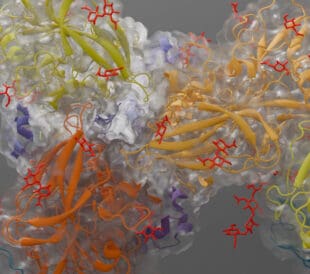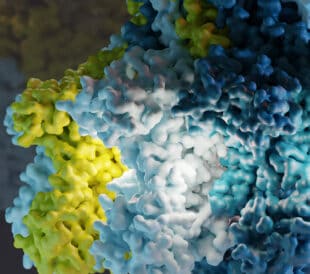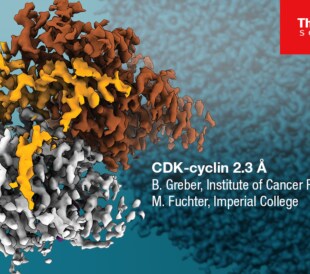Today, G protein-coupled receptors (GPCRs) are the most intensely studied class of drug targets, accounting for approximately 35 percent of approved drugs. As the pharmaceutical industry seeks to better understand how these membrane proteins function, cryo-electron microscopy (cryo-EM) is opening up unprecedented opportunities for structure-based drug discovery. A deeper understanding of the structure of GPCRs is expected to revolutionize how drugs are designed, helping to better treat a wide range of diseases from diabetes to heart disease to schizophrenia.
What are GPCRs?
As the largest family of cell surface receptors, GPCRs are essential to the normal functioning of the human body. They also generate abnormalities in cellular communication that can lead to disease. Rational drug development that targets GPCRs is considered key to reducing side effects and personalizing medication for each patient. Until recently, scientists were unable to unlock the high-resolution structures of these membrane proteins, which limited their understanding of how GPCR ligands elicit function.
GPCRs are small, asymmetrically shaped, and unstable, making them difficult to image and characterize. They are notoriously difficult to work with because of their instability when extracted from lipid bi-layers. Active complexes are even more challenging because several additional protein components need to be brought together and trapped within a conformation that would otherwise fall apart within milliseconds.
Cryo EM workflows developed by Dr. Patrick Sexton
Among the scientists at the forefront of GPCR research is Dr. Patrick Sexton, a professor at the Monash University Institute of Pharmaceutical Science in Australia. Dr. Sexton and his team have turned to cryo-EM to help uncover the structure of GPCRs at resolutions of less than three angstroms, and the advances uncovered by his laboratory’s research have led to collaborations with several pharmaceutical companies. To bring his groundbreaking work to the wider pharmaceutical industry, Thermo Fisher Scientific invited Dr. Sexton to share his workflows during a series of practical workshops next year.
Dr. Sexton and his team have developed a cryo-EM workflow that overcomes many of the imaging challenges. Using cryo-EM to study the structure of highly challenging GPCR complexes, they are learning how different drugs act on GPCRs. More precisely, they are creating the potential to develop targeted drugs that selectively activate beneficial pathways while avoiding the less beneficial signals that lead to side-effects.

Dr. Patrick Sexton and his team at Monash University are using cryo-EM to uncover the structure of highly challenging GPCR complexes. Their work is expected to revolutionize pharmaceutical drug design.
By understanding the relative importance of different pathways, Dr. Sexton and his team are paving the way for a new generation of medicines that can more precisely treat a wide range of neurological, metabolic, and cardiovascular diseases. They also believe they can reverse the function of severely damaged cells, improving the outcomes of patients previously considered beyond treatment.
GPCR cryo EM workshop
Dr. Sexton’s “GPCR Cryo-EM and Drug Design” workshop series will focus on different parts of his workflow from protein production, specimen preparation, and grid screening to data collection and reconstruction.
Please sign up now to provide feedback on which aspects of GPCR you would like to see covered in a workshop, and let us know if you are interested in a short-term placement of working alongside Dr. Sexton’s team.
To be the first to learn more about these upcoming workshops, register here.
Additionally, we are hosting a webinar with Science, “Harnessing cryo-EM to investigate GPCR structure and discover new medicines” on May 27. Register here to listen to Dr. Jackie Oberst (Science/AAAS) moderate a discussion with Dr. Matthew Belousoff (Monash University) and Dr. Stacey Southall (Sosei Heptares).
Mazdak Radjainia is a staff scientist at Thermo Fisher Scientific.
Subscribe now to receive Accelerating Microscopy updates straight to your inbox.
///
Speak with an expert: https://www.thermofisher.com/blog/microscopy/speak-with-an-expert/
Subscribe now: https://www.thermofisher.com/blog/microscopy/subscribe-to-accelerating-microscopy/




Leave a Reply